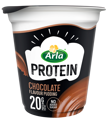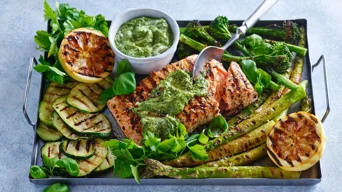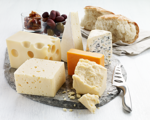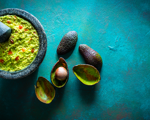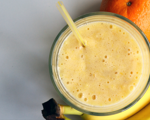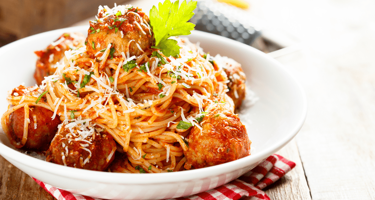
Protein can come from many different sources, encompassing both animal-based and plant-based ones, and they are important for, among other things, maintaining normal bones and muscles.
This article consists of two main parts, where we present some high-protein meats and high-protein fish that you can add to your diet. To make it easy, we have made two tables, where we indicate the meat/fish and their protein content in grams per 100 grams and the percentage of the total energy value.
Discover the types of animal protein with the highest protein content
There are a lot of sources of animal protein to choose from if you want this type of protein to be a part of your diet. High-protein meats and fish can be eaten as part of meals throughout the day. They are often included in lunch and dinner, and you can easily combine them if you want different flavours and textures.
In the following, we present two tables of high-protein meat and high-protein fish, respectively.
High protein meat
Meat is a central component of many culinary traditions, and its multi-faceted taste and texture make it a palatable source of protein for a lot of people.
Many types of meat are generally high in protein, and here below, we have listed some of the options.
| Meat | Protein content (per 100g) | % of the total energy value |
|---|---|---|
| Goose, only flesh | 22.8 | 58.5 % |
| Pork loin, lean | 22.3 | 84.2 % |
| Beef topside | 22.3 | 76.4 % |
| Pheasant, only flesh | 22.2 | 73.6 % |
| Pheasant, skin on | 21.7 | 51.8 % |
| Beef meat, lean (< 5 % fat) | 21.5 | 69.6 % |
| Chicken breast | 21.5 | 58.6 % |
| Turkey, only flesh | 21.3 | 81.6 % |
| Beef rump steak | 21.3 | 69.9 % |
| Veal short loin | 21.3 | 54.5 % |
| Pork tenderloin, trimmed | 21.2 | 74.5 % |
| Beef flank steak | 20.6 | 58.8 % |
| Veal rump | 20.6 | 58.5 % |
| Veal brisket | 20.5 | 56.5 % |
| Rabbit | 20.4 | 70.1 % |
| Turkey, skin on | 20.2 | 65 % |
| Duck breast | 19.4 | 67.4 % |
| Lamb shoulder | 18.5 | 32.8 % |
| Duck, only flesh | 18.3 | 58.7 % |
| Lamb leg | 17.9 | 40.6 % |
How much protein is in goose?
The most protein-rich meat on our list, if we look at grams per 100 grams, is goose. It contains 22.8 grams of protein per 100 grams of goose flesh, corresponding to 58.5 % of the total energy value.
How much protein is in beef?
As you probably know, there are many cuts of beef, which is also shown by the fact that beef is present the most times on our list, holding four spots out of the 20 in total. The one with the most protein is beef topside, containing 22.3 grams per 100 grams, equalling 76.4 % of the total energy value.
Popular around the world, this flavourful type of red meat offers a lot of great cooking opportunities. The many cuts mean there is plenty of room to experiment with different ones to discover your favourites. Generally, beef has a rich, savoury flavour and a slightly sweet taste.

How much protein is in pork?
Pork also takes up several spots on our list, with lean pork loin ranging highest. It contains 22.3 grams of protein per 100 grams, just like beef topside, and protein contributes 84.2 % of the total energy value, which is higher than the beef topside.
Pork has a mild and slightly sweet flavour. It is tender, especially when cooked properly, and can absorb the flavours of marinades and seasonings well. It is used in many cuisines around the world, meaning there is a wealth of tasty recipes to choose from.
How much protein is in lamb?
At the bottom of our top 20 high-protein meats is leg of lamb. Although it ranges 20 out of 20, it is still a high-protein option containing 17.9 grams of protein per 100 grams, which equals 40.6 % of the total energy value. Lamb has a distinct, somewhat gamey flavour. It is tender and has a slightly sweet, grassy taste, especially in younger cuts.
how much protein is in poultry?
A list of meats high in protein would, of course, not be complete without poultry. We have already mentioned goose, but pheasant, chicken, turkey, and duck are also present in this top 20 high-protein meats.
As you can see, there is a big difference in the percentage of protein between, for example, pheasant or turkey with and without skin on. You can dive deeper into the protein content of different cuts of chicken if you want to know more.
In general, duck tends to have a richer, bolder flavour than chicken and turkey, but due to their naturally mild flavours, these high-protein poultries are all great at taking on flavour from various seasonings and marinades.
High protein meat FAQs
High-protein meats include goose, pork loin, beef topside, and chicken breast. Each of these meats provides a significant amount of protein per 100 grams, with goose having the highest protein content.
Yes, red meat is generally high in protein. Cuts like beef topside and beef rump steak are examples of red meats with substantial protein content. Red meat offers a rich, savoury flavour and is a popular choice for many dishes, providing a significant amount of protein per serving.
A chicken breast contains approximately 21.5 grams of protein per 100 grams.
The protein content in steak can vary depending on the cut. For example, beef topside contains about 22.3 grams of protein per 100 grams, while beef rump steak has approximately 21.3 grams of protein per 100 grams.
High-protein fish
Fish is a staple in many cuisines around the world. With its delicate textures and a range of flavours from mild to strong, fish is a delicious ingredient with many possibilities. In addition, many fish count as high-protein foods.
| Fish | Protein content (per 100g) | % of the total energy value |
|---|---|---|
| Tuna | 26.8 | 91.9 % |
| Cod roe | 23.2 | 77.6 % |
| Salmon, pacific, wild | 21.2 | 81.2 % |
| Ling | 19.5 | 97.8 % |
| Pikeperch | 19.2 | 88.7 % |
| Pike | 19 | 85.2 % |
| Sole | 18.7 | 88.3 % |
| Trout, rainbow | 18.7 | 52.4 % |
| Trout, lake | 18.6 | 52.2 % |
| Salmon, Atlantic, wild | 18.4 | 47 % |
| Haddock | 17.9 | 93.3 % |
| Flounder | 17.9 | 83.8 % |
| Trout, sea | 17.9 | 55 % |
| Mackerel | 17.8 | 38.8 % |
| Hake | 16.3 | 94.9 % |
| Herring | 16.5 | 35.8 % |
| Halibut | 12.3 | 28.3 % |
How much protein is in Tuna?
Tuna tops the list with 26.8 grams of protein per 100 grams, and as much as 91.9 % of the total energy value in tuna comes from protein. Tuna is popular for its firm texture and its versatility, making it suitable for many different dishes, including lunches and dinners.
However, if we look at the protein percentage, tuna “only” ranges fourth with ling, hake, and haddock above. In these fish, protein contributes 97.8 %, 94.9 %, and 93.3 %, respectively, of the total energy value.
How much protein is in Salmon?
Salmon is probably also one of the most popular fish on our list. Depending on the type, salmon usually contains 18.4-21.2 grams of protein per 100 grams, equalling 47-81.2 % of the total energy value. Featuring a delicious, rich flavour and a tender, flaky texture, it is a popular choice for a large variety of recipes, and it can be enjoyed throughout the day from breakfast over lunch to dinner.

How much protein is in Cod?
When it comes to high-protein fish options, cod is also a great choice. Cod roe, for instance, contains 23.2 grams of protein per 100 grams, contributing to 77.6% of its total energy value. This makes cod roe a rich source of protein. Whether grilled, baked, or steamed, cod can be a delicious and healthful addition to your meal plan.
At the bottom of the list is halibut, a mild and sweet white fish containing 12.3 grams of protein per 100 grams, equalling 28.3 % of the total energy value. Although it ranges 17 out of 17 on our list, it is still considered a high-protein fish, because protein constitutes more than 20 % of the total energy value.
High protein fish FAQs
Yes, fish is generally high in protein. Fish such as tuna, salmon, and haddock have substantial protein content, making them excellent choices for adding protein to your diet. Fish also offers a variety of textures and flavours, from mild to strong, enhancing its appeal as a nutritious ingredient.
Tuna is one of the highest-protein fish, containing 26.8 grams of protein per 100 grams. Other high-protein fish include cod roe, salmon, and haddock. These fish not only provide a rich source of protein but also contribute significantly to the total energy value derived from protein in your diet.
If you like these kinds of overviews, you should take a look at our tables of high-protein vegetables and protein in fruits. You can also dig into this more general presentation of high-protein foods.


